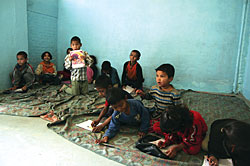 MIRKO MANCINELLI |
Poverty is evident wherever one goes in Nepal, and the capital is no exception. The street kids of Kathmandu are perhaps the most obvious signs of this malaise: Child Workers in Nepal (CWIN) estimates there are around 5,000 street children working and living on the streets of Nepal.
This number continues to grow, with roughly 300 to 500 children leaving home every year for a variety of reasons. Some do so because of abusive, alcoholic parents, maltreatment at home, peer influence, and the temptation to earn more money. But life on the streets is hard, especially for younger children, and as a consequence they often end up taking drugs, abusing alcohol, and even suffering sexual abuse at the hands of locals and foreign tourists.
Peer pressure is one reason for drug taking among street children. A 2002 report by CWIN detailed the devastation: "The consequences of alcohol and drug use on street children's lives range from acute and chronic health and emotional problems to disruption in interpersonal relationships, school failure, social marginalisation and criminal behaviour."
Drugs, in particular, are often taken by street children to help them forget about their problems and overcome hunger. The most commonly used are cannabis, heroin, opium, glue, boot polish, and petrol. The generosity of tourists may only perpetuate the vicious cycle of abuse.
The situation of street children in Kathmandu may seem almost beyond repair at first glance. But there are grups in the capital helping get children off the streets.
HELP/Nepal, for instance, has established a home for street children near Pashupati. Hamro Ghar? provides a warm, safe and welcoming environment where street children can sleep, shower, eat, study, receive medical care, and play with other children their own age.
The house currently sleeps around 40 boys and girls between the ages of 3 and 17. During the day, that number often surges to around 70. The children come to Hamro Ghar to escape the harsh realities of life on the street, and here they have the opportunity to learn English, Maths, and Nepali as well as sewing for the girls. A second house, just behind Hamro Ghar, is due to be completed early this year and will offer a vocational course in baking.
It's easy to dismiss such efforts as drops in the pond. With thousands of children on the streets, the vast majority in Kathmandu, it's not easy to reach everyone. Yet the work of organisations such as HELP/Nepal is vital and effective.
One of the problems in working to rehabilitate street children is actually getting them to abandon their lives on the street. The International Labour Organization's International Programme on the Elimination of Child Labour (IPEC) notes that children become hardened after spending time on the streets, and resist going back to a more structured environment where they must do what others tell them to. But Hamro Ghar aims to give these children a very real alternative to street life. Far from locking them back into the adult world many escaped from in the first place, the program seeks to help children break the destructive cycle of drug and alcohol abuse and create a better future for themselves.
HELP/Nepal has started working with those who represent the future of Nepal.
READ ALSO:
Miracle in Kalimati - FROM ISSUE #483 (01 JAN 2010 - 07 JAN 2010)


